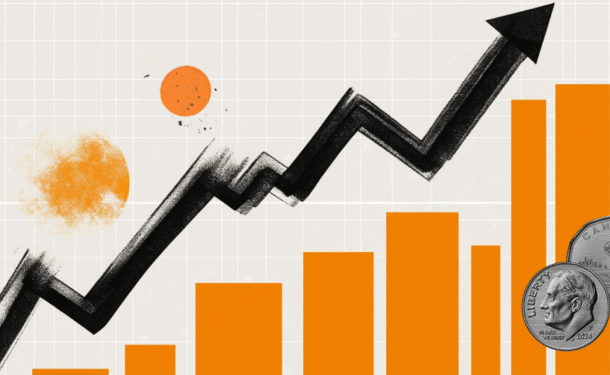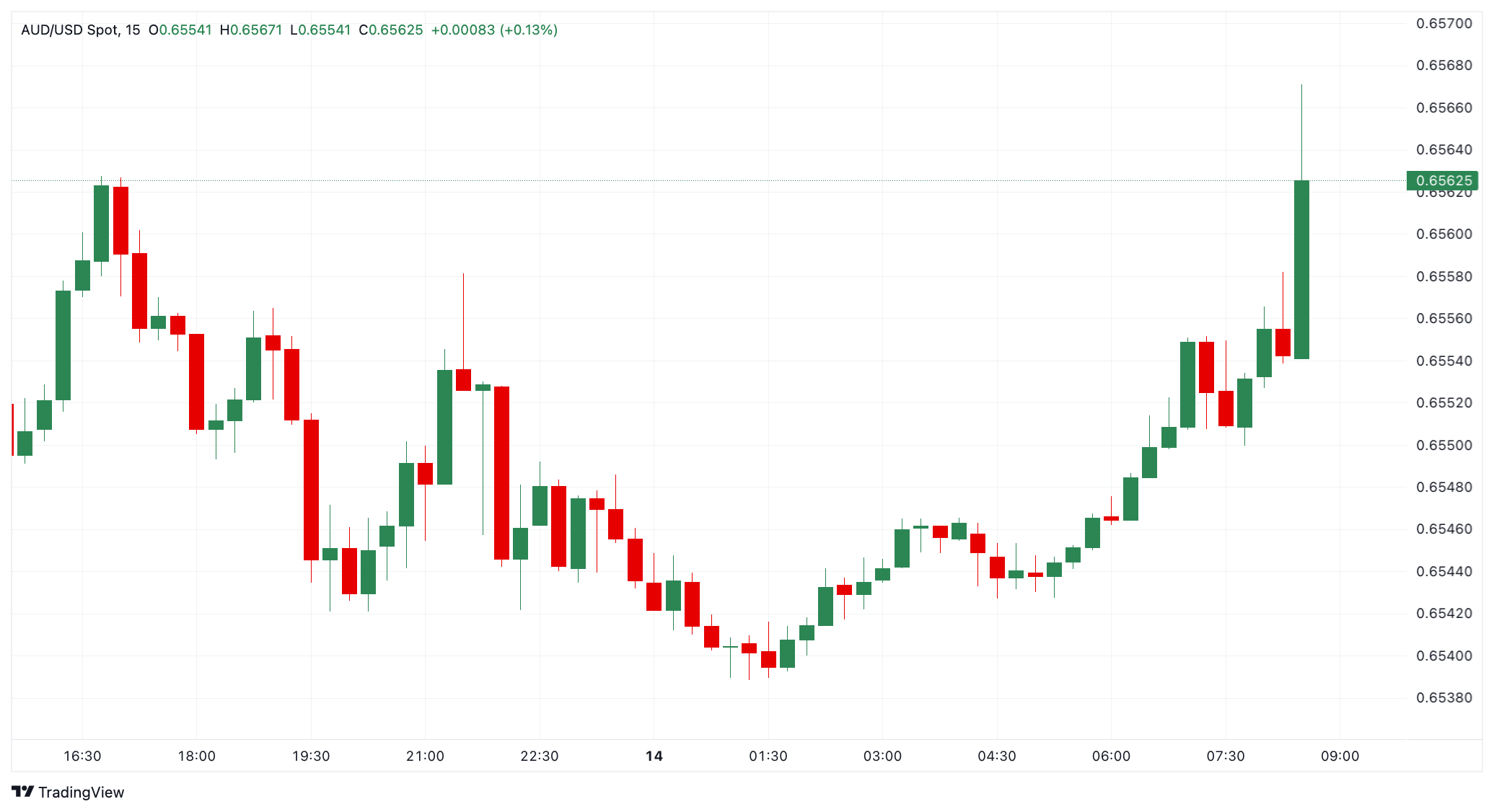
Australia’s Unemployment Rate dropped to 4.2% in July from 4.3% in June, according to the official data released by the Australian Bureau of Statistics (ABS) on Thursday. The figure came in line with the market consensus of 4.2%.
Furthermore, the Australian Employment Change arrived at 24.5K in July from 1K in June (revised from 2K), compared with the consensus forecast of 25K.
The participation rate in Australia held steady at 67.0% in July, compared to 67.0% in June (revised from 67.1%). Meanwhile, Full-Time Employment increased by 60.5K in the same period from 37.6K in the previous reading (revised from -38.2K). The Part-Time Employment decreased by 35.9K in July versus an increase of 40.2K prior.
Sean Crick, ABS head of labour statistics, said with the key highlights noted below
The growth in employment resulted in the employment-to-population ratio rising slightly to 64.2 per cent.
The female employment-to-population ratio and participation rate reached 60.9 per cent and 63.5 per cent respectively, both new historical highs.
Hours worked rose 0.3 per cent in July, slightly higher than the monthly employment growth (+0.2%).
Market reaction to the Australia’s employment data
The Australian Dollar (AUD) attracts some buyers following the employment data. At the time of writing, the AUD/USD pair is trading 0.26% higher on the day to trade at 0.6562.
(This story was corrected on August 14 at 03:45 GMT to say, in the first paragraph, that “the figure came in line with the market consensus of 4.2%, not below the market consensus”)

AUD/USD 15-min chart
Australian Dollar PRICE Last 7 days
The table below shows the percentage change of Australian Dollar (AUD) against listed major currencies last 7 days. Australian Dollar was the strongest against the Canadian Dollar.
| USD | EUR | GBP | JPY | CAD | AUD | NZD | CHF | |
|---|---|---|---|---|---|---|---|---|
| USD | -0.37% | -1.60% | -0.51% | 0.17% | -0.70% | -0.71% | -0.10% | |
| EUR | 0.37% | -1.24% | -0.12% | 0.53% | -0.34% | -0.39% | 0.26% | |
| GBP | 1.60% | 1.24% | 1.13% | 1.80% | 0.92% | 0.86% | 1.54% | |
| JPY | 0.51% | 0.12% | -1.13% | 0.68% | -0.16% | -0.24% | 0.48% | |
| CAD | -0.17% | -0.53% | -1.80% | -0.68% | -0.86% | -0.93% | -0.24% | |
| AUD | 0.70% | 0.34% | -0.92% | 0.16% | 0.86% | -0.04% | 0.63% | |
| NZD | 0.71% | 0.39% | -0.86% | 0.24% | 0.93% | 0.04% | 0.69% | |
| CHF | 0.10% | -0.26% | -1.54% | -0.48% | 0.24% | -0.63% | -0.69% |
The heat map shows percentage changes of major currencies against each other. The base currency is picked from the left column, while the quote currency is picked from the top row. For example, if you pick the Australian Dollar from the left column and move along the horizontal line to the US Dollar, the percentage change displayed in the box will represent AUD (base)/USD (quote).
This section below was published at 21:30 GMT on Thursday as a preview of the Australia Employment report
- The Australian Unemployment Rate is foreseen at 4.2% in July, down from the 4.3% hit in June.
- Australia is expected to have added 25,000 new positions in the month, after two months of disappointing figures.
- The Reserve Bank of Australia trimmed the Official Cash Rate to 3.6% in its August meeting.
- AUD/USD is technically bullish and could revisit the July peak at 0.6625.
Australia will release its July monthly employment report on Thursday at 1:30 GMT, following the Reserve Bank of Australia (RBA) decision to trim the Official Cash Rate (OCR) by 25 basis points (bps) to 3.6%.
The Australian Bureau of Statistics (ABS) is expected to announce that the country added 25,000 new job positions in the month, after adding the measly 2,000 announced in June. The Unemployment Rate is foreseen declining to 4.2% after spiking to 4.3% in the previous month, while the Participation Rate is expected to remain unchanged at 67.1%.
Australian ABS reports both full-time and part-time positions through the monthly Employment Change. Generally speaking, full-time jobs imply working 38 hours per week or more and usually include additional benefits, and they mostly represent consistent income. On the other hand, part-time employment generally means higher hourly rates but lacks consistency and benefits. That’s why the economy prefers full-time jobs.
Back in June, the country lost 38,200 full-time positions, while adding 40,200 part-time ones, quite a discouraging employment report.
Australian unemployment rate expected to tick lower in July
The Australian monthly employment report has offered relatively tepid readings for two months in a row. The economy lost 2,000 positions in May and added 2,000 in June. The May negative reading included a sharp decline in part-time jobs, making it less worrisome than the June one. Despite ending up positive, the latest employment report included a massive decline in full-time positions.
A loosening labour market is generally understood as negative for the economy, but it also means the central bank has no reason to keep interest rates at high levels. Most central banks have claimed that the strength of the sector has somehow limited their decisions to go further down with record rates, and Australia is no exception.
The latest employment figures have prompted the RBA’s Board to note that “Labour market conditions have eased further in recent months,” although policymakers said that conditions remain a “little tight.”
The central bank met earlier this week and, as previously noted, decided to trim the benchmark rate by 25 bps from 3.85% to 3.6%. Policymakers’ decision was unanimous, as they also agreed that inflation has continued to moderate. Other than that, the Board remains cautious about the outlook, while acknowledging that there is “a little more clarity on the scope and scale of US tariffs and policy responses in other countries, suggesting that more extreme outcomes are likely to be avoided.”
Finally, the RBA forecasts inflation to remain within its goal for this year and the next two, while growth is expected to be at 1.7% in 2025 and advance to 2.1% in 2026. Regarding the Unemployment Rate, policymakers forecast it at 4.3% between 2025 and 2027.
RBA Governor Michele Bullock offered a press conference following the rate announcement and clarified that a larger rate cut was not on the table. Still, Bullock said that the Board forecasts imply the cash rate might need to be lower to achieve price stability.
Meanwhile, it is worth adding that Australian wage growth remained stable in the second quarter of the year, according to the latest ABS report. The wage price index grew 3.4% on a yearly basis, the same rate of increase as seen in the three months to March, and slightly above the 3.3% anticipated. However, on a quarterly basis, the wage price index rose 0.8% in Q2, easing from the previous 0.9% and matching expectations.
With that said, tepid job creation is helping reduce interest rates, which in the end, will translate into economic progress. Generally speaking, a strong employment report, with a further easing of the Unemployment Rate and more solid job creation, should provide a boost to the Australian Dollar (AUD). The opposite scenario is also valid, with a softer-than-anticipated outcome putting pressure on the AUD.
When will the Australian employment report be released and how could it affect AUD/USD?
The ABS July report will be released early on Thursday, and as previously noted, the Australian economy is expected to have added 25,000 new job positions in the month, while the Unemployment Rate is foreseen at 4.2% and the Participation Rate at 67%.1.
Ahead of the announcement, the AUD/USD pair posted a nice comeback from the post-RBA low at 0.6481 and hovers around 0.6550 as a better market mood took its toll on the US Dollar (USD). Steady inflation in the United States (US), as reported by the Bureau of Labor Statistics (BLS) through the monthly Consumer Price Index (CPI) report, fueled speculation that the Federal Reserve (Fed) will deliver a rate cut when it meets in September.
Valeria Bednarik, Chief Analyst at FXStreet, notes: “The AUD/USD pair trades near a fresh two-weekly high of 0.6562, and is technically poised to extend its advance. In the daily chart, a bullish 100 Simple Moving Average (SMA) has provided support since mid-April, currently standing at around 0.6440, and a potential bottom should the pair collapse with the news. In between, near-term supports come at 0.06520 and 0.6470.”
Bednarik adds: “The AUD/USD pair peaked at 0.6625 in July, with gains beyond the recent weekly high favoring a test of the level. Once beyond it, AUD/USD can rally towards the 0.6670 region before finding near-term sellers.”
Australian Dollar FAQs
One of the most significant factors for the Australian Dollar (AUD) is the level of interest rates set by the Reserve Bank of Australia (RBA). Because Australia is a resource-rich country another key driver is the price of its biggest export, Iron Ore. The health of the Chinese economy, its largest trading partner, is a factor, as well as inflation in Australia, its growth rate and Trade Balance. Market sentiment – whether investors are taking on more risky assets (risk-on) or seeking safe-havens (risk-off) – is also a factor, with risk-on positive for AUD.
The Reserve Bank of Australia (RBA) influences the Australian Dollar (AUD) by setting the level of interest rates that Australian banks can lend to each other. This influences the level of interest rates in the economy as a whole. The main goal of the RBA is to maintain a stable inflation rate of 2-3% by adjusting interest rates up or down. Relatively high interest rates compared to other major central banks support the AUD, and the opposite for relatively low. The RBA can also use quantitative easing and tightening to influence credit conditions, with the former AUD-negative and the latter AUD-positive.
China is Australia’s largest trading partner so the health of the Chinese economy is a major influence on the value of the Australian Dollar (AUD). When the Chinese economy is doing well it purchases more raw materials, goods and services from Australia, lifting demand for the AUD, and pushing up its value. The opposite is the case when the Chinese economy is not growing as fast as expected. Positive or negative surprises in Chinese growth data, therefore, often have a direct impact on the Australian Dollar and its pairs.
Iron Ore is Australia’s largest export, accounting for $118 billion a year according to data from 2021, with China as its primary destination. The price of Iron Ore, therefore, can be a driver of the Australian Dollar. Generally, if the price of Iron Ore rises, AUD also goes up, as aggregate demand for the currency increases. The opposite is the case if the price of Iron Ore falls. Higher Iron Ore prices also tend to result in a greater likelihood of a positive Trade Balance for Australia, which is also positive of the AUD.
The Trade Balance, which is the difference between what a country earns from its exports versus what it pays for its imports, is another factor that can influence the value of the Australian Dollar. If Australia produces highly sought after exports, then its currency will gain in value purely from the surplus demand created from foreign buyers seeking to purchase its exports versus what it spends to purchase imports. Therefore, a positive net Trade Balance strengthens the AUD, with the opposite effect if the Trade Balance is negative.
Economic Indicator
Unemployment Rate s.a.
The Unemployment Rate, released by the Australian Bureau of Statistics, is the number of unemployed workers divided by the total civilian labor force, expressed as a percentage. If the rate increases, it indicates a lack of expansion within the Australian labor market and a weakness within the Australian economy. A decrease in the figure is seen as bullish for the Australian Dollar (AUD), while an increase is seen as bearish.
The Australian Bureau of Statistics (ABS) publishes an overview of trends in the Australian labour market, with unemployment rate a closely watched indicator. It is released about 15 days after the month end and throws light on the overall economic conditions, as it is highly correlated to consumer spending and inflation. Despite the lagging nature of the indicator, it affects the Reserve Bank of Australia’s (RBA) interest rate decisions, in turn, moving the Australian dollar. Upbeat figure tends to be AUD positive.
Information on these pages contains forward-looking statements that involve risks and uncertainties. Markets and instruments profiled on this page are for informational purposes only and should not in any way come across as a recommendation to buy or sell in these assets. You should do your own thorough research before making any investment decisions. FXStreet does not in any way guarantee that this information is free from mistakes, errors, or material misstatements. It also does not guarantee that this information is of a timely nature. Investing in Open Markets involves a great deal of risk, including the loss of all or a portion of your investment, as well as emotional distress. All risks, losses and costs associated with investing, including total loss of principal, are your responsibility. The views and opinions expressed in this article are those of the authors and do not necessarily reflect the official policy or position of FXStreet nor its advertisers. The author will not be held responsible for information that is found at the end of links posted on this page.
If not otherwise explicitly mentioned in the body of the article, at the time of writing, the author has no position in any stock mentioned in this article and no business relationship with any company mentioned. The author has not received compensation for writing this article, other than from FXStreet.
FXStreet and the author do not provide personalized recommendations. The author makes no representations as to the accuracy, completeness, or suitability of this information. FXStreet and the author will not be liable for any errors, omissions or any losses, injuries or damages arising from this information and its display or use. Errors and omissions excepted.
The author and FXStreet are not registered investment advisors and nothing in this article is intended to be investment advice.








